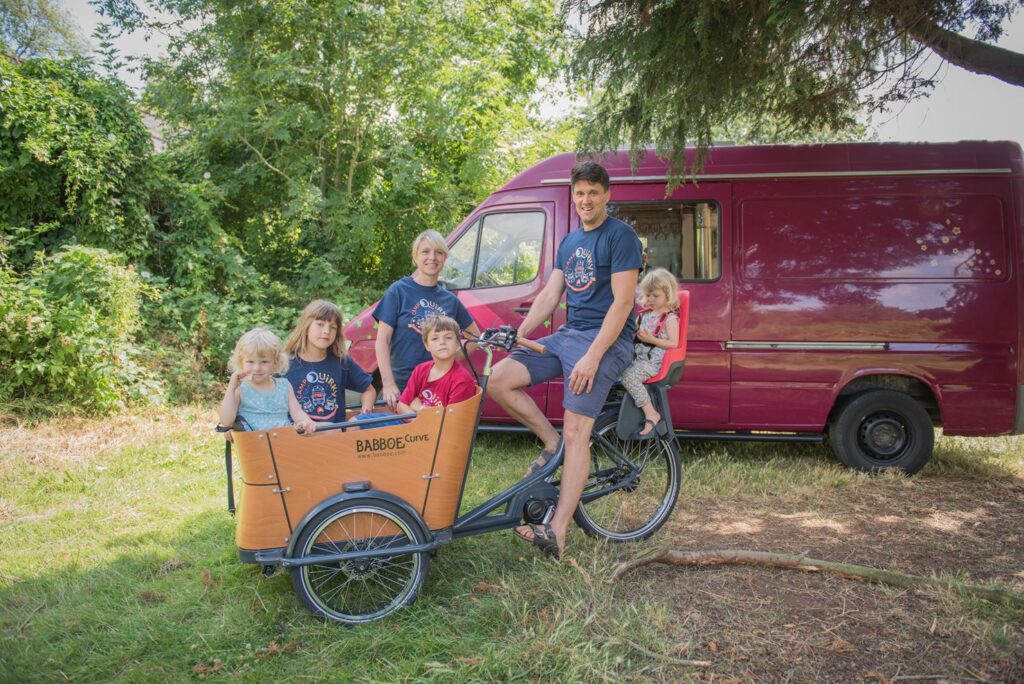Home » Choosing the best family cargo bike
Choosing the best family cargo bike
Our search for the perfect family bike to replace owning a car
How did our cargo bike journey start?
I came late to cycling, only taking it up properly at the age of 19. But since then the bicycle has been my primary mode of transport. In fact I have never owned a car. We do of course own our treasured campervan Bella, but she is saved for holidays or trips which involve an overnight stay. I don’t enjoy driving round the city, dealing with traffic jams and searching for parking spaces, so I hoped that having children wouldn’t mean moving to a more car-based lifestyle.
As it turned out this was easy with our first child – most people will be familiar with the commonly used bike seats that go in front or behind the rider on a regular bike. However, when when we found out that our second child was in fact twins and we would soon have three children under 3 one of our first thoughts was ‘oh no, we’re going to have to buy a car!’
Thankfully I only spent a few weeks gloomily researching family cars before the Taga 2.0 popped into my Facebook newsfeed and I realised it was possible to carry three kids on a bike. Even in hilly city like Bristol. To be honest I didn’t spend much time looking at other options as it felt too overwhelming. And being in the crowdfunder stage, the Taga was significantly cheaper than anything else my cursory research threw up. It wasn’t the best option but it was the cheapest option out there.
Why we love owning an electric family bike
Two years and 3500km later and we are hooked on electric bikes. We have saved thousands of pounds, buckets of tears (none of our kids have been fans of car seats), lots of time (most of our journeys are quicker), and half a tonne of CO2. Here is a run-down of all our favourite things about being a cargo-bike family:
- The journey is part of the experience; we’re happy, the kids are happy and we can all chat and sing and look at interesting things together
- You can fit a trolleys worth of groceries in it.
- Getting in and out is easy and the kids can do it themselves
- You can get your vehicle into the park – great for a quick getaway when the witching hour sets in!
- There’s space to pack a day’s worth of supplies, we can set off up the cycle path with no particular plan and see where we end up.
- You can stop anywhere; cue lots of unexpected learning experiences.
- Experiencing the change of seasons – it’s much easier to notice subtle changes in the trees and plants of our daily route.
- Feeling like a celebrity! These bikes are still so rare in this country that it is very common for people to wave and smile and ask lots of questions about our bike.
- Most of the trips we do are quicker as we can take a more direct route and save on getting in and out of car seats and finding parking spaces.
Next we wanted to upgrade to a four seater so we can pick up play dates for our kids and carry a bit more stuff for longer day trips or bigger adventures. We were also looking for something a bit sturdier. This time round we looked at the whole market because we know that every penny will be well spent.

Our main choices
There is a myriad of choices when it comes to family and cargo bikes but there are a couple of key variables that will help narrow it right down.
Our guiding principle has always been that it should be as easy and convenient as possible to use our bike. Partly because life with 3 kids is already challenging enough and partly because we didn’t think we would inspire many other people to follow suit if we were not making it look like fun. It’s worth considering what your values are in relation to your bike to help in your decision.
Two wheels or Three wheels (Bicycle vs Tricycle)
If you need seats for 3 or more children, then this decision is pretty much made for you because we’ve not come across two-wheelers with seats for 3 kids. But if you only need seats for 2 children then here are some of the main differences between bicycles and tricycles.
Two-wheelers have the advantage of feeling very similar to ride compared to a regular bike, mainly because they lean when you turn. The extent to which tricycles will lean when turning or generally how well they handles corners, will depend very much on the design of the turning mechanism which I’ll describe in more detail on the separate models below. Two-wheelers tend to be a bit narrower and some of them have cargo boxes which can even fold inwards making them no wider than a normal bike. Great if you want to store it indoors.
The advantage of a three wheeler is the added stability at slow speeds even when doing hill starts, turning corners on hills or going up and down curbs. This was less of a factor for David being 6’2” and strong but for me at 5’3” it makes a huge difference. Add up the weights of your children (and imagine what they will weigh in a couple of years) plus the weight of the bike, then imagine trying to stabilise that once it starts to tip. They are however very hard to get up curbs and generally much wider.
People worry about where to store a three wheeler as it is unlikely to fit through your front door. It’s not an issue for us as our garden is at the front of our house with a wide front gate but that is not the case for everyone. It is worth thinking creatively about storage solutions – if you are able to fit a wall or ground anchor you can simply lock it to that- we also use a motion sensor alarm for added security.
Electric vs. non-electric
The electric versus non-electric argument is pretty straightforward. The electric versions of any of these cargo bikes are significantly more expensive; usually an additional thousand pounds or more. However, although cheaper to purchase, unless you happen to live in an exceptionally flat area or really relish a daily physical challenge, a non-electric cargo bike may end up as little more than expensive decoration. The electric assist makes it easy, fast and pleasurable to use and a genuine alternative to a car.
Types of Electric assist: Hub vs. Crank
There are two main types of electric motor: Hub and Crank. A hub motor is situated in the middle (hub) of either the front or back wheel. A sensor on the peddles or wheels tell the motor whether to run or not and handlebar controls allows you to set the target speed the motor should be aiming for. Hub motors don’t measure the effort you are putting so you can effectively let the motor do all the work. Having a hub motor on the back wheel will mean you cannot have internal gearing system so they will either have no gears (like the taga 2.0) or use the traditional rear derailleur gear system.
A crank motor is located between or next to the pedals. The handlebar controls will have an adjustable input setting but rather than a target speed they control the additional power the motor will put in. So for example it will be your efforts plus 50%, 100%, 150% etc. Both types of motor are limited to 18mph or 26kmh which is an EU standard for all electric bike used on public roads and paths. Generally, crank motors have better performance than hub but there is also a big difference in build quality in both types so it’s not always a straightforward comparison.
Having experienced a hub motor for 2 years we knew we wanted to go for a crank motor. Mainly because it would give us greater range but also to have the satisfaction of feeling like it was being propelled by us as well as the motor.
Our Choice
We knew that we wanted a bike with the following:
- Capacity to carry 4 children
- 3 wheels
- Electric motor
So this narrowed us down to 4 suitable models:
- Christiania – Danish, been around a while, elegant bike, square carriage, solid build
- Backfiets – Dutch original, quite basic
- Nihola – Canadian, funky design with small bike and oblong carriage,
- Babboe – Dutch, been around 15 years, elegant bike and curved design
Now there is only so much that you can learn from online research and we knew from experience that nothing beats actually trying a bike to fully understand it’s limitations and advantages So the question became where could we try each of these options? After lots of searching finding places that only stocked one or two of these or that didn’t respond to emails or answer the phone we found the amazing London Green Cycles.
Test Driving at London Green Cycles
Within a day of contacting them we had comprehensive quotes for three different models and they were available for us to come and try the bikes anytime. From start to finish the service was fantastic. The only problem was they are in London and we are in Bristol….so we decided to make a day of it. The next available Saturday we hopped on the train and headed for Paddington. We’ve got used to using our bike to get around so being squashed on the busy tube train with two 3-year-olds and a 5-year-old was an intense experience.
The front of shop is located on a busy north London street but out the back there is access to a couple of very quiet residential streets which are perfect for putting the bikes through their paces. So one by one we strapped the kids in and gave these cycles a test.
Nihola 4.0 – The most noticeable design difference of the Nihola is how low the carriage is to the ground. This gives it a very low centre of gravity which gives great stability and makes for comfortable cornering but it also means the clearance is quite poor. This could be a problem if you are covering uneven ground, poorly designed speed bumps or curbs. The steering is similar to the Taga in that the front wheels turn whilst the carriage doesn’t. The carriage overhangs the front wheel a long way which could cause tipping when the rider isn’t on the seat. To prevent that from happening there is a clever ‘foot’ that props it up. The advantage of the over hang is an excellent turning circle.
Babboe Mountain Curve – it’s big and beautiful. Like most of the cargo bikes the carriage is made of plywood but the curved design gives it a much more modern feel than many others. The front wheels are in the middle of the carriage giving it a comparatively poor turning circle. Steering involves moving the whole carriage left to right which allows the carriage to be much wider than on the Nihola or Taga but also increases the turning circle. The back wheel is 20 inches in diameter which gives a smooth ride and the overall build is high quality and long lasting. Lights are incorporated and the battery is neatly stowed under the seat in the carriage.
Christiania – With its history rooted in the synonymous free state in Copenhagen Christiania cargo bikes have been there since the beginning. The swooping frame is beautiful and simple and the carriage is still the same square design its always been. Like the Babboe steering involves moving the whole box.
Decision Time
From our internet research the aesthetic of the Babboe Curve had been our favourite but we wanted to keep an open mind until we’d been for a test drive, seen the build quality and experienced the handling. So having tried them all we had a quick recap and decided to hire the Babboe for the rest of the day to really get a feel for it. We headed to Regents Park and after a spin through the beautiful gardens we stopped for some lunch. This gave us time to discuss at length with all the family the pros and cons of all 3 options. By the time we took the bike back and headed for the tube we had all but decided. The only thing to check was width of the bollards on the cycle path on the way to school. The Babboe is 89cm at its widest point which is 9cm wider than the Taga. The guys at London Green Cycles had told us the standard width for bollards is 100cm but we just wanted to check. Tape measure in hand we whizzed up the path to confirm this and by bed time the decision had been made.
The order took a few days to finalise and then 3 weeks to arrive. It came fully assembled and ready to ride.

Can I afford it?
The cost of a cargo bike can feel prohibitive, they start at £2k and can go up to £10k, with most electric cargo bikes coming in at around £3500-£4000. However if you can use it to replace a second car, or replace car ownership altogether you will be making huge savings. We have borrowed this table from Babboe’s website comparing the running costs of an electric cargo bike to an economical Citroen C1 – it shows a monthly saving of £360! You could do the same calculation on your own car.
| Monthly cost | Car | Electric bike |
| Repair | £43.00 | £20.00 |
| Fixed charges | £72.00 | £8.00 |
| Petrol costs / Recharge costs | £100.00 | £2.50 |
| Maintenance | £92.00 | £3.75 |
| Value decrease | £114.00 | £24.00 |
| Total: | £421.00 | £58.25 |
This isn’t the full picture. There are longer trips which we can’t do in the bike and for these we either use a car-share scheme or hire a car for the time we need it. This averages at about £70/month. It also allows us to drive far more efficient cars than we could afford to own.
Final thoughts
If you are thinking about buying a cargo bike as an alternative to a second car (or even better, an alternative to owning a car at all) we couldn’t recommend it more emphatically. Do it!




